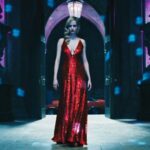 Spooky or Kooky? Tim Burton’s Campy Dark Shadows
Spooky or Kooky? Tim Burton’s Campy Dark Shadows
By Armond White
Gone are the days when Tim Burton films made you laugh first. Now Burton more likely makes you cringe as in Dark Shadows, his new film version of TV’s 1960s daytime soap opera. It retells the story of Barnabas Collins, an early American fishing scion, who had been turned into a vampire by Angelique, a witch he spurned. “She caused me to be a vampire so that my suffering would never end” says Barnabas (Johnny Depp) in tones so sepulchral they’re almost satiric. Yet, Burton loses his signature balance of dread and humor. There’s an indecisive, scattershot approach to both vampire legend and pop culture camp. It’s as if Burton couldn’t decide to be kooky or spooky.
Burton’s done genre make-overs before yet Dark Shadows isn’t a transformation like his 2001 Planet of the Apes or his do-over Batman Returns which definitively grasped the comic-fright tone missing from his now-forgotten 1989 Batman blockbuster. Burton’s Dark Shadows never takes hold as a gothic vision of American history (Sleepy Hollow II) or a comedy about love vs. spite, the occult vs. the all-too-mortal follies that transpire within the personalized crosscurrents of ruthless business practices in the Collins family saga.
Some of all of that occurs throughout Dark Shadows, but only in flashes: primarily when Barbabas and Angelique (Eva Green) combine sexual tension with commercial competition. Their seduction scenes (frolicking among Pop Art paintings like the Partyman museum vandalizing sequence) combine simultaneously with corporate hi-jinks. If this jokiness isn’t the fault of an inferring studio mandate, then blame Burton’s confused artistic impulses.
Burton had developed his own idiosyncratic approach to genre and sentimentality in such enjoyable films as Pee Wee’s Big Adventure, Ed Wood, Mars Attacks (his masterpiece), Beetlejuice, Batman Returns and Charlie and the Chocolate Factory. But the mix of gloomy/gleeful tones in Dark Shadows (such as the poorly-timed joke when 230-year Barnabas misinterprets McDonald’s golden arches), suggests he’s lost his mirth.
The ghoulishness that has overtaken Burton’s filmmaking–in the nightmarish operetta Sweeney Todd and the lackluster freakshow Alice in Wonderland–vitiates his unique, usually macabre satire. Burton’s benign nerdiness now clashes with Dark Shadows’ strange pop culture anachronisms (the story is set in 1982). The original Dark Shadows program was inadvertently campy; through serialization of the horror genre it meant to attract a younger audience, engrossed in human mystery and the fantastic. But the show became a source of amusement for emotionally detached viewers. When Burton joins their scoffing ranks, he winds up with something messily uneven: A ball scene with Alice Cooper (and some of the original soap opera cast) proves desperately inconsistent with Burton’s wry morbidity.
This Dark Shadows borrows from the campy Addams Family films as much as various scenes re-play the outsider anxieties of Edward Scissorhands–not Burton’s finest moment although probably essential to understanding his fantasy life. Making sexy camp is a devolution for a once original pop artist. Burton was smart to get Johnny Depp’s best deadpan readings (“You may immediately place your wonderful lips upon my posterior and kiss it repeatedly”) and lucky to cast wonderfully histrionic Eva Green as Angelique, a ghoul in the shell of a vixen. When Angelique cries, her tears fall in the cracks of her decaying visage–at last an image worthy of Burton and equal to the improbable mash-up of Barnabas’ clawing Nosferatu fingers.
